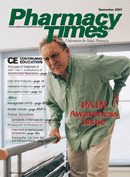Publication
Article
Pharmacy Times
Many Choices for Pharmacists Counseling Osteoarthritis Patients
Dr. Pelegrin is a pharmacy manager with Publix and an associate clinical professor at the University of Florida College of Pharmacy (UF COP). At the time of this writing, Dr. Torres was a PharmD candidate at the UF COP.
Osteoarthritis (OA), also knownas degenerative joint disease,is characterized by gradual lossof cartilage. It is the most common formof arthritis in the United States and amajor factor in chronic disability. Thosepatients with OA generally have painwhen undergoing physical activity andweight-bearing exercise; this painimproves with rest. Unlike other conditionssuch as rheumatoid arthritis,inflammation in OA is usually mild andlimited to the affected joint(s). Inflammationis typically seen in older patients;however, young people can develop it,usually as a consequence of a joint injury,joint malformation, obesity, or geneticfactors. Symptoms usually occur earlierin life in women, yet prevalence is equalamong men and women.
Osteoarthritis affects primarily theweight-bearing joints of the axial andperipheral skeleton, causing pain, limitationof motion, deformity, and progressivedisability. Patients with OA usuallyfeel joint pain and stiffness. The mostcommonly affected joints are those inthe hands, neck, lower back, knees, andhips. There is no cure for OA, but treatmentis aimed at alleviating pain andimproving quality of life.
The aging process leads to OA, yetother factors increase the risk as well:
- Injuries resulting from certain sportsor other physical activity, causingjoints to degenerate
- Gender?women are more likely todevelop OA
- Genetics
- Obesity?excess weight affectsjoints
Treatment
As OA progresses, prolonged stiffnessand enlargement of the joints may beevident, including limitation of daily activities.
Treatment is aimed at reducing pain,improving function of the affected joints,decreasing stiffness, and preventing ordecreasing disability, as well as improvingquality of life. Yet, treatment ispatient-specific and consists first andforemost of educating the patient andfamily members about the course of thedisease, as well as preventive measuresand treatment modalities.
Exercise has been shown to beextremely helpful in building musclestrength, enhancing flexibility, and resultingin weight reduction. Physical therapy,support devices, and heat are otheroptions. Other devices include appropriatefootwear, walking canes, kneebraces, and heel wedging.Drug TherapyOsteoarthritis is best managed with acombination of nonpharmacologic therapyand drug therapy. Drug therapyincludes both prescriptionand OTCmedications?acetaminophen,nonsteroidalanti-inflammatorydrugs (NSAIDs)when there is inflammationinvolved, cyclooxygenase-2 (COX-2) specific inhibitors,and topical formulationssuch as capsaicin.For more severepain, stronger prescriptiondrugs areavailable, as well as injectable corticosteroidsand hyaluronic acid.AcetaminophenThe American College of Rheumatologyrecommends acetaminophen as first-linetherapy for OA for its effectiveness intreating patients with mild-to-moderatepain, but it does not treat inflammation. Itis cost-effective, is available OTC in variousstrengths, and generally causesfewer adverse effects than NSAIDs. Thedaily dose should not exceed 4 g, andregular alcohol consumption when combinedwith acetaminophen can result inliver toxicity.NSAIDsFor those patients who do not improvewith acetaminophen and who experienceinflammation, NSAIDs are the goldstandard in treating OA. NSAIDs includeOTC products such as aspirin, ibuprofen(Advil, Motrin), and naproxen (Aleve),with ibuprofen and naproxen available byprescription in higher strengths. Thoseavailable by prescription only includenabumetone (Relafen), diclofenac(Voltaren, Cataflam), piroxicam (Feldene),and meloxicam (Mobic). All NSAIDs arepresumed to have the same therapeuticeffects, depending on the patient, yetthey are to be usedcautiously in the elderlybecause of gastrointestinal(GI) andrenal adverse effects.Because inflammationplays a small role inOA, studies haveshown that there is noadvantage to usingNSAIDs over acetaminophen.Topical PainRelieversMany OTC productsare available in theform of creams, ointments,and gels. Theycontain ingredientssuch as menthol,camphor, and salicylates.Capsaicin, atopical formulationmade from hot chilipeppers, is often recommended in conjunction with oral agents. Itreduces pain by depleting substance P, a chemical involved in thetransmission of pain. It should be used qid, and the best resultsare seen after a few weeks of daily use.Other Agents
Celecoxib (Celebrex), the only COX-2 inhibitor presently on themarket, has equal therapeutic effect to NSAIDs, but it can still produceadverse GI effects. Hyaluronic acid is a component of bothcartilage and synovial fluid and helps maintain joint function. It isavailable in intra-articular injections under the brand names ofHyalgan and Synvisc.
Tramadol (Ultram), a centrally acting drug, has no therapeuticeffect on inflammation but can be used for pain relief with less ofthe GI side effects caused by NSAIDs. Injectable corticosteroidsare occasionally used but only on a short-term basis due to theiradverse side effects.
Glucosamine, often combined with chondroitin, is availableOTC. It has been studied extensively, and many studies haveshown analgesic efficacy in treating OA. These agents are for themost part safe but may take several weeks to stimulate the productionof building blocks of cartilage.
Suggested Reading
Altman R, Hochberg M. Recommendations for the medical management of osteoarthritis of the hip and knee. Arthritis Rheum. 2000;43(9):1905-1915.
Altman RD. Osteoarthritis: Aggravating factors and therapeutic measures. Postgrad Med. 1986; 80(2):150-163.
American College of Rheumatology. Osteoarthritis. Available at: www.rheumatology.org/public/factsheets/oa_new.asp. Accessed June 14, 2007.
Boh L, Elliot E. Osteoarthritis. In: Dipiro JT, Talbert RC, Yee GC, et al. Pharmacotherapy: A Pathophysiologic Approach. 5th ed. New York, NY: McGraw-Hill; 2001:1639-1656.
Haq I, Murphy E, Dacre J. Osteoarthritis. Postgrad Med J. 2003;79:377-383.
Hinton R, Moody RL, Davis AW, Thomas SF. Osteoarthritis: diagnosis and therapeutic considerations. Am Fam Physician. 2002;65(5):841-848.
Mayo Clinic. Osteoarthritis. www.mayoclinic.com/health/osteoarthritis/DS00019. Accessed June 11, 2007.
Singh G. Treatment options for osteoarthritis. Surg Technol Int. 2003;11:287-292.







